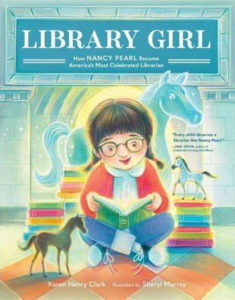13 September 2022
32 pages
—Ryan’s Review of the Writing—
Karen Henry Clark’s new picture book, Library Girl, shares the story of how Detroit native Nancy Pearl transformed her childhood love for books into a lifelong mission. From the start, Nancy was able to ignore how her peers teased her because her best friends were in books (“all those characters tucked into pages”). Clark cleverly uses bookish language throughout the text, such as how when the school librarian told Pearl about a nearby public library that was open on Saturdays, “Hope fluttered like pages turning in Nancy’s heart.”
Two sweet librarians at the public library encouraged Nancy’s imagination and her love for horses (Nancy had toy horses in her bedroom and she even imagined her bicycle was a horse named Charger). Though she hid her new library books to avoid more teasing, Nancy “read through rows of fantasies, trilogies, diaries, anthologies, dictionaries, histories, biographies, and mysteries.” And as so often happens to voracious young readers, all those stories led to this powerful realization–“I can be anything when I grow up.”
Nancy didn’t remain a solitary bookworm. When her librarian friends asked her to give a talk about horse books to the other kids, she couldn’t say no. Their belief in her was that strong, though she was understandably nervous. Even a spill on her bike en route to the library to give the talk didn’t spoil things. The other kids were “spellbound,” and when she was done, they clapped and the librarians “glowed.” I’ll let Austin talk about the art but I’ll add that many of the spreads have a magical glow to them, even when Nancy’s imagination isn’t being depicted in action.
After Nancy’s successful talk, the book fast-forwards to where she has found her future as an adult librarian who helps other kids discover their own magic in books. An Author’s Note explains some of Nancy’s successes as a champion for books, reading, and libraries, though one of the most memorable moments is Nancy’s response to being challenged to write a six-word memoir: “Girl discovers books, then discovers life.” The back matter also briefly lists awards Nancy won, books she wrote, and recognition she received.
While Nancy Pearl isn’t a household name, her sweet, empowering story will resonate with many readers. Book lovers, teachers, and librarians in specific will surely see some part of themselves in Library Girl.
4.5 out of 5 pencils
—Austin’s Review of the Illustrations—
It may seem obvious to say the work of an illustrator is to supply the “show” in “show and tell;” to provide tone and context beyond the reach of words alone. That’s exactly what Sheryl Murray’s depictions of the world of librarian Nancy Pearl’s childhood in the early 1950s accomplish.
Of the five books Murray has illustrated to date, Library Girl is the only one with a non-fiction, biographical subject, but Murray’s fanciful sensibilities serve her well here, infusing Nancy’s experience with constant companions in sparkling azure shades, especially horses. Each scene is suffused with a magical pastel glow, a consistent palette perfectly suited to the romanticism of Nancy’s imagination. We would be remiss, however, if we failed to appreciate the subtle clues that set the mise en scene firmly in its historical context–the rolled-up jeans, the milkman, and who could fail to be inspired by the palatial renderings of Detroit’s Parkman Branch Library?
An author herself as well as an illustrator, Murray’s firm grasp of visual storytelling are on dramatic display here. Beyond the warmth and approachability of Murray’s style, her framing and inclusion of evocative elements of the narrative add a textural richness to the reading experience: the dotted line of the map to the library, the bird landing nearby when the text mentions fluttering pages. The pulled back pictures that underscore Nancy’s emotional state when she feels small and insecure, the shots over her shoulder that put us in her black and white saddle shoes, which is especially appropriate in the story of a librarian who famously encouraged everyone in Seattle to read the same book at the same time. Murray’s illustrations allow us to see through Nancy’s eyes without telling us exactly how to feel. They give us permission to ask ourselves–as Nancy’s librarian mentors do–what helps us feel brave?
Nancy Pearl’s accomplished career as a librarian focused on outreach has been about understanding through shared experiences in books, and Murray’s charming compositions help enrich just such an experience for us–the readers of Nancy’s story.
4.5 out of 5 crayons



